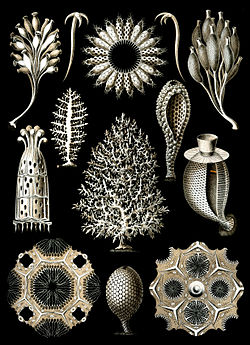| Calcareous sponges | |
|---|---|
 | |
| "Calcispongiae" from Ernst Haeckel's Kunstformen der Natur , 1904 | |
| Scientific classification | |
| Kingdom: | Animalia |
| Phylum: | Porifera |
| Class: | Calcarea Bowerbank, 1864 |
| Subclasses | |
The calcareous sponges [2] [3] or calcereans are sponges that make up the class Calcarea, characterized by spicules made of calcium carbonate in the form of high-magnesium calcite or aragonite. While the spicules in most species are triradiate (with three points in a single plane), some species may possess two- or four-pointed spicules. [4] [5] Unlike the far more common siliceous sponges, calcareans lack microscleres, tiny spicules which reinforce the flesh. In addition, their spicules develop from the outside-in, mineralizing within a hollow organic sheath. [6]











